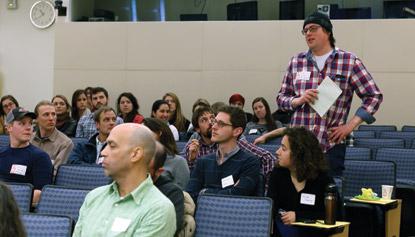Equal Exchange talks big change in bananas at conference

An Ecuadorian banana farmer, produce managers, industry experts, students, and business allies gathered in Boston in late March for a conference titled, “The Future of Authentic Fairtrade Bananas.”
Equal Exchange, a fair-trade food importer based in Massachusetts, brought together a panel of speakers, including: Fabiola Ramon, president of El Guabo cooperative in Ecuador; author Dan Koeppel; Lianne Zoeteweij, general manager of El Guabo; Alistair Smith, founder of Banana Link; Ben & Jerry’s CEO Jostein Solheim; and Hans-Willem van der Waal, CEO of Agrofair.
One focal point of the three-day conference was nurturing alternative and cooperative-driven supply chains, which offer an alternative to business as usual. When consumers learn the history and human suffering behind the conventional banana, they discover “how unfair this fruit really is,” said Nicole Vitello, president of Oke USA/Equal Exchange Bananas (www.beyondthepeel.com).
Artificially low price
The average American eats close to 26 pounds of this staple grocery in a year. This strong demand, combined with global pressure from retailers and distributors to keep prices low, creates oppressive conditions on banana plantations throughout the world—where approximately 90 percent of the fruit comes from.
“It’s a tough thing, and prices have to go up. Retailers have to stop using bananas as a loss leader,” said Koeppel, author of Bananas: The Fate of the Fruit that Changed the World.
Koeppel said research conducted by Chiquita has shown that people are willing to pay $1 per pound. However, several buyers at the conference noted that retail price hikes at their stores—up to $1.19 per pound—did not hurt sales.
Smith, international coordinator for the U.K.-based nonprofit Banana Link, said the global banana market exhibits an “unfair distribution of value.” For example, societal costs and environmental impacts (including a large carbon footprint due to extensive shipping) are not incorporated into the cheap banana prices to which shoppers have grown so accustomed.
Meanwhile, Chiquita had net sales of $2 billion in 2013—a figure that is sure to rise after its recent merger with Fyffes.
Fair trade seeks a more equitable distribution of the pie for farmers and laborers, one in which social premiums are incorporated in the wholesale price of every case of bananas. This sustainable business model is “extremely valuable” in how it sets minimum pricing, Smith said. The $1 per box premium charged by Equal Exchange helps improve living standards by defraying costs of teacher salaries, water treatment systems, health clinics, and more.
Education and the mission of fair trade
“We are all consumers in the end. We are not researchers when we go shopping,” said El Guabo’s Zoeteweij.
Growers’ improved knowledge base is one of fair trade’s success stories, Zoeteweij said. They are becoming more educated through the certification process. Still, consumers do not know the difference between big banana plantations and small producers, she said.
Adding to the confusion, a plethora of fair-trade labels floods grocery shelves. Solheim, Ben & Jerry’s chief executive, counted 430 labels when he researched the industry. The Vermont-based ice cream maker, which already sources fair-trade vanilla, banana puree, cocoa, and coffee ingredients, is in the midst of a fair-trade transition for its entire product line.
“There is no endgame in social or environmental justice,” Solheim said. “The point is you have to keep going.”
Several panelists emphasized the importance of storytelling and communicating the positive mission of fair trade. One workshop, led by Solheim and Equal Exchange Director of Purchasing Todd Caspersen, focused on the challenges of taking fair trade mainstream—or what they called “scaling up.”
Caspersen noted how corporate takeovers and diluted standards occurred after organic food hit the big stage in 2002, following the introduction of the National Organic Program. The marriage between local, sustainable food systems and the well-oiled logistics of corporations is not always smooth, Solheim said. Ingredients must be uniform, on time, and in the correct amounts—requirements that small growers and producers might not be able to meet all the time, he said.
After three days of networking, back-and-forth discussion, and celebration, participants headed back home to their stores, cooperatives, schools, and communities to continue working on a more sustainable and just food system.







